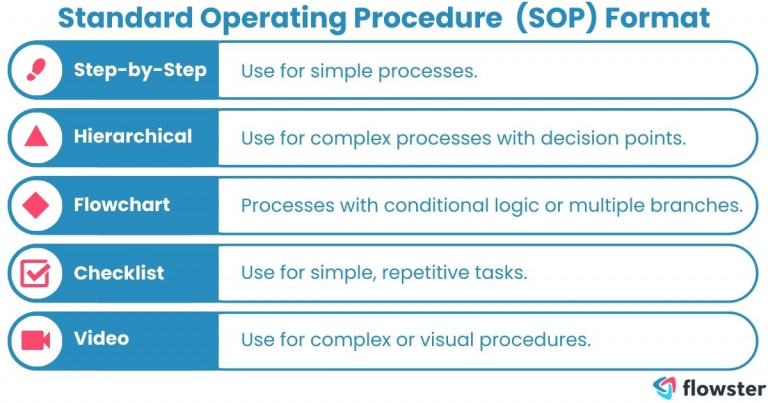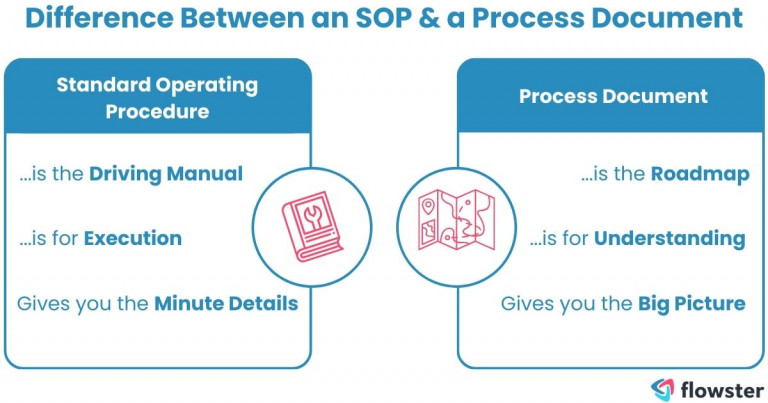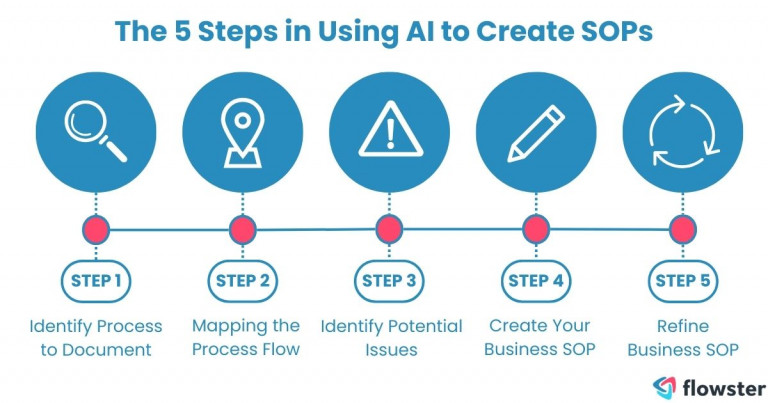Imagine this: You’re at the helm of a thriving business, but suddenly, you hit a snag. Projects are delayed, errors are cropping up, and your team seems to be in a constant state of confusion. The culprit? Inconsistent procedures. A solution? Learn how to create sop.
This is where Standard Operating Procedures (SOPs) come in as a game-changer. SOPs are more than just documents; they are the blueprint for your business’s success. By implementing effective SOPs, you can enjoy a boost in efficiency, a leap in quality, and a significant reduction in errors. So, let’s get started.
Article Outline
Standard Operating Procedures: Demystifying SOPs
Let’s start at square one: What exactly are SOPs? This part breaks down what standard operating procedures are and why they’re a big deal for any business, big or small.
- What are SOPs? In simple terms, SOPs are detailed, written instructions designed to achieve uniformity in the performance of specific functions. They are the step-by-step process for complex procedures, ensuring regulatory compliance and efficiency. Think of them as a recipe for your business’s success.
- Why are SOPs important? SOPs are crucial for any business aiming for consistency and quality. They serve as a central guide for employees, ensuring everyone is on the same page. This leads to fewer mistakes, better quality control, and a more streamlined workflow.
- Who uses SOPs? From healthcare to manufacturing, customer service to IT, SOPs are ubiquitous. They are not confined to any one industry but are a universal tool for improving operations across various sectors.
Curious about SOP benefits?
For a deeper understanding of how SOPs can transform your business operations and drive success, dive into Beatrice Anim’s insightful exploration of the Benefits of Having SOPs in Your Business. This article offers real-world examples and expert insights that underscore the vital role SOPs play in organizational efficiency and effectiveness.
How to Create SOP: Building Your Blueprint
Now, let’s roll up our sleeves and get into the nitty-gritty of making SOPs. Here, you’ll learn how to spot which processes need SOPs or detailed instructions and how to lay them out clearly and effectively.
- Identifying processes to document: The first step is pinpointing which processes in your business need SOPs. Look for areas where errors are frequent or where processes are complex and require step-by-step instructions. This is essential to turning an outdated SOP into an effective one.
- Gathering information and data: Before you start writing, it’s essential to collect all necessary information. This might include existing SOP documents, regulatory requirements, and input from team members who are experts in the process.
- Structuring your SOPs: A well-structured SOP follows a specific SOP format, making it easy to follow. Start with a clear title, then outline the purpose, scope, materials needed, and steps involved. Don’t forget to include any resources that might be helpful. For those unsure where to start, a free SOP template can be an invaluable resource.
Need a detailed SOP guide?
For an in-depth guide on crafting your SOPs with clarity and precision, delve into the comprehensive resource, How to Write SOP Templates: Create Clear, Concise, and Effective SOPs. This blog post offers valuable insights and practical tips to streamline your SOP creation process, ensuring your documents are not just functional but also user-friendly.

Writing SOPs: Crafting Compelling Content
It’s showtime for your SOPs! This section dives into how to make your SOPs clear, engaging, and easy to follow. You’ll learn the secrets to writing SOPs that everyone can understand and actually wants to use.
- Clarity is key: The language in your SOP document should be simple, direct, and easy to understand. Avoid jargon and technical terms that might confuse your team. Remember, an effective standard operating procedure hinges on its clarity and comprehensibility.
- Visualize the process: Incorporate diagrams, flowcharts, or screenshots to make the procedures easier to grasp. A picture is worth a thousand words, especially when it comes to complex processes. Utilizing standard operating procedure examples can also be beneficial in illustrating best practices.
- Version control and updates: Processes evolve, and so should your SOPs. Establish a system for updating your documents to ensure they always reflect the most current practices. Regularly revising your standard operating procedure templates ensures that they remain effective and relevant.
Want to learn AI-based SOPs?
Enhance your SOP creation process with modern technology by exploring AI-Powered SOP Creation: How to Make Business Procedures Easy to Understand and Follow. This resource delves into innovative ways AI can simplify and improve the clarity of your standard operating procedures, making them more accessible and effective for your team.
Transform Your Business with Flowster's AI-Driven Automation
Implementing SOPs: Unleashing the Power
Ready to bring your SOPs to life? Here, we explore the best ways to train your team on your new SOPs, keep them easily accessible, and ensure they stay up-to-date and effective as your business grows and changes.
- Training and onboarding: When introducing new SOPs, ensure your team is thoroughly trained. This is crucial for seamless implementation.
- Accessibility and visibility: Make your SOPs easily accessible to all staff members. They should be able to refer to these documents whenever necessary.
- Continuous improvement: Encourage feedback and regularly review your SOPs. This practice helps keep them relevant and effective.
Curious about SOP implementation challenges?
Implementing SOPs is not without its challenges. To gain insights into common obstacles and how to overcome them, read Nikhil Agarwal’s insightful piece, 5 Difficulties Faced in Implementing SOPs. This article sheds light on the hurdles businesses often encounter during SOP implementation and provides practical solutions to navigate them effectively.
Bonus! Free SOP Template for Developing SOPs
Here’s a free template to get you started. Create an effective Standard Operating Procedure (SOP) using this template. Simply click the “Complete Task” button down below.
AI: A Modern Twist in Crafting and Managing SOPs
In the fast-paced digital era, artificial intelligence (AI) is redefining the landscape of standard operating procedures (SOPs). AI brings a fresh perspective to SOP creation, transforming them from static documents into dynamic, intelligent guides. This tech-savvy approach allows for SOPs that are not just comprehensive but also adaptable to ever-evolving business needs.
AI’s role in SOPs extends beyond mere creation; it personalizes content for varied users, ensuring relevance and ease of understanding. With AI, SOPs are more than just instructions; they’re intelligent tools that evolve with your business, offering insights and foresight into operational efficiencies.
Want to learn how AI affects business processes?
For a closer look at how AI is reshaping SOPs in contemporary business settings, check out “AI for SOPs: How AI Can Improve Your Business Processes for Success in 2024.”. This article sheds light on AI’s transformative role in enhancing SOPs and gearing your business towards success in the digital age.
How to Create SOP: See the Benefits Effective SOPs
Standard Operating Procedures are not just documents; they are the backbone of a successful business. By learning how to write standard operating procedures and create standard operating procedures, you’re setting a standard for excellence in your operations. Now is the time to take action and harness the power of SOPs. Start creating your own, and watch as they bring about a transformation in your business. For more insights and business tips, don’t forget to subscribe to our blog. Let’s embark on this journey to operational excellence together!
Having difficulty creating standard operating procedures?
You can easily create standard operating procedures or workflows with Flowster by leveraging the power of AI, or you can browse our library of pre-built SOP templates in the Flowster Marketplace.
Do you require assistance? Use our “Done for You” services to have our quality and improvement experts design custom workflows for you.




